
by Cameron Macht
March 2023
Economic disparities between people of color and white people are notable and often significant in the United States and Minnesota. Though they have been lessening with time, Americans who identify as Hispanic or Latino1 still face disparities in our country and state, as foundational systemic barriers to prosperity persist. As policymakers, community leaders, businesses, and workforce leaders craft approaches to remove these barriers, one thing we hear consistently is that disaggregated data by race and origin is essential.
Understanding the demographic trends and scope of disparities is an important tool for crafting stronger solutions for communities. This analysis offers an updated look at some of the major demographic, labor force, economic, and educational trends and disparities in the Hispanic or Latino community in Minnesota.
| Table 1. Population Change in Minnesota, 2010-2020 | ||||||
|---|---|---|---|---|---|---|
| - | Minnesota | United States | ||||
| - | 2020 Population | 2020 Percent | Change from 2010-2020 | 2020 Percent | ||
| Total Population | 5,706,494 | 100.0% | +402,569 | +7.6% | 100.0% | |
| White | 4,423,146 | 77.5% | -100,916 | -2.2% | 72.5% | |
| Black or African American alone | 398,434 | 7.0% | +124,022 | +45.2% | 12.7% | |
| American Indian/Alaska Native | 68,641 | 1.2% | +7,725 | +12.7% | 0.8% | |
| Asian & Other Pac. Islander | 302,108 | 5.3% | +85,718 | +39.6% | 5.7% | |
| Some Other Race | 168,444 | 3.0% | +65,444 | +63.5% | 4.9% | |
| Two or More Races | 345,721 | 6.1% | +220,576 | +176.3% | 3.3% | |
| Hispanic or Latino (any race) | 345,640 | 6.1% | +95,382 | +38.1% | 18.7% | |
| Source: U.S. Census Bureau | ||||||
According to the 2020 Census, Minnesota was home to more than 345,000 residents who reported Hispanic or Latino origin, accounting for 6.1% of the state's total population. While the state's population grew 7.6% over the past decade, the state's Hispanic or Latino population increased 38%, the equivalent of more than 95,000 new residents, accounting for nearly a quarter of the state's total population growth during that time. In addition to an increasing number of residents of Hispanic or Latino origin, Minnesota's population is rapidly becoming more racially diverse (see Table 1).
Among the 50 states, Minnesota has the 22nd largest population overall with 5,706,494 residents, and the 29th largest Hispanic or Latino population, with 345,640 people. At 6.1% of the total population, Minnesota had the 38th highest percentage of Hispanic or Latino residents; compared to 18.7% nationwide and a high of 47.7% in New Mexico. Among neighboring states, Wisconsin ranks 32nd with 7.6%, Iowa ranks 37th with 6.8%, South Dakota ranks 44th with 4.4%, and North Dakota ranks 46th with 4.3% of the population reporting Hispanic or Latino origin.
Though Minnesota still has a relatively small Hispanic or Latino population, the 38% increase over the past decade was both the 28th largest numeric increase and the 28th fastest increase among all states from 2010 to 2020. In comparison, the Hispanic or Latino population increased 23% in the U.S. overall since 2010, putting us above the national rate and just ahead of Wisconsin (+33.1%), but well behind both North Dakota (+148.1%) and South Dakota (+75.1%), which ranked 1st and 2nd in the U.S. respectively. Iowa also saw faster growth in its Hispanic population from 2010 to 2020, rising 42.5% to rank 17th.
According to the 2021 American Community Survey (ACS), just over 60% of Minnesota's Hispanic or Latino population was of Mexican ethnicity, about 12% reported South American origin (primarily Ecuadorian and Colombian), about 11% reported Central American origin (primarily Guatemalan and Salvadoran), and just under 5% are Puerto Rican. The remaining 17% have other Hispanic or Latino ethnicity, including Cuban, Dominican, Spanish, or some other origin.
Due to a younger age profile and a large number of births over the past 2 decades, a much higher percentage of Minnesota's Hispanic or Latino population is under 35 years of age than the state's white population, which is aging. Nearly 30% of the state's Hispanic or Latino residents are under 15 years old, compared to less than 19% of the total population; while just 4.5% of Hispanic or Latinos are 65 years and over, compared to 16.8% of the overall population. In sum, 38.2% of the state's population is in their prime working years, between 25 to 54, compared to 40.7% of Hispanic or Latinos in Minnesota (see Figure 1).
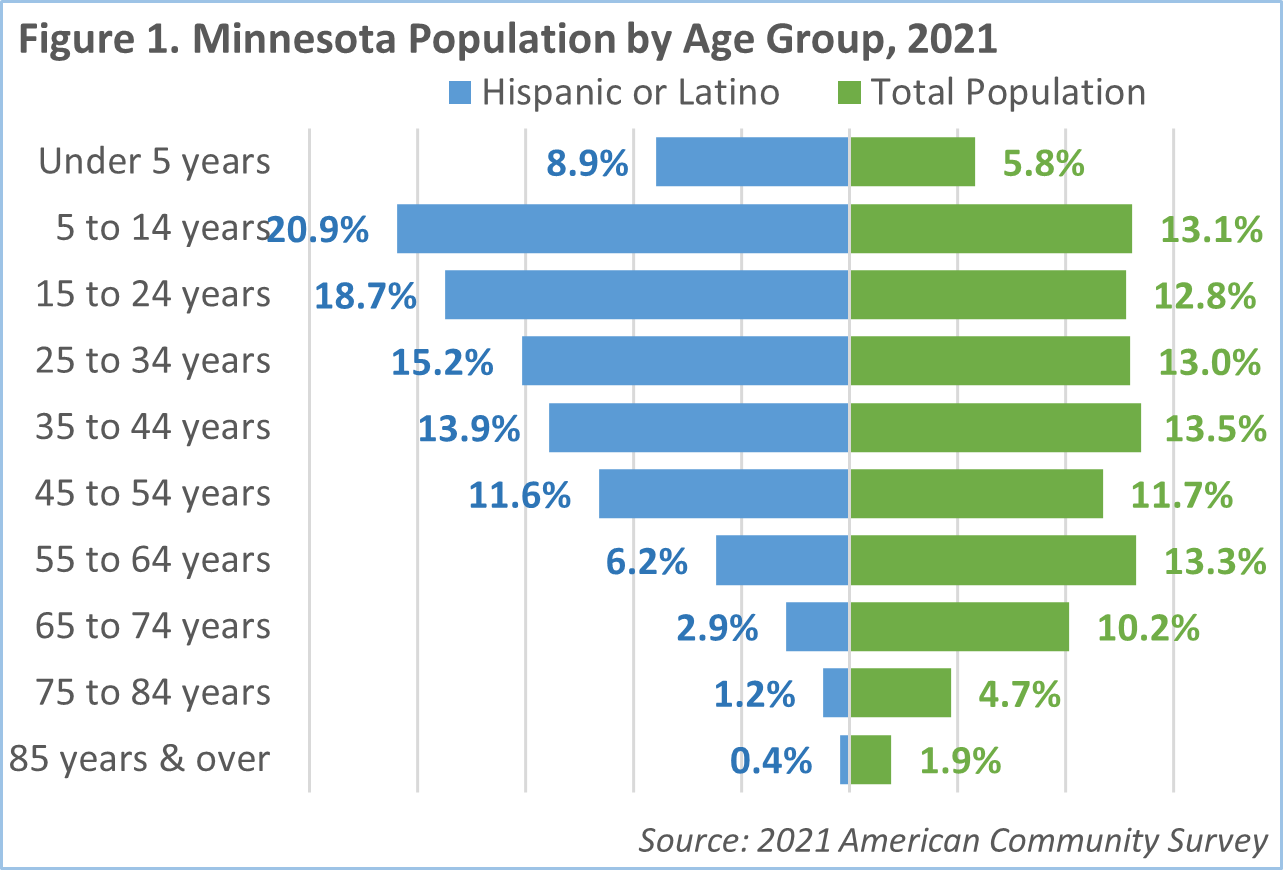
In addition to a natural rate of increase (more births than deaths), Minnesota's Hispanic or Latino population has also been growing through international in-migration. According to ACS, between 2010 and 2021, Minnesota welcomed more than 112,000 new foreign-born residents from across the world, including nearly 9,000 new immigrants from Latin America, which includes Mexico (ACS includes Mexico under Central America in its data tables). Because recent growth was much faster from Africa and Asia, Latin America is now the third largest source of foreign-born residents in the state, after Asia and Africa (see Table 2).
| Table 2. Place of Birth for the Foreign-Born Population, 2021 | Minnesota | Change from 2010-2021 | ||
|---|---|---|---|---|
| Number | Percent | Number | Percent | |
| Total, Foreign-born Population | 479,231 | 8.5% | +112,280 | +30.6% |
| Europe | 45,121 | 9.4% | +117 | +0.3% |
| Asia | 177,107 | 37.0% | +41,060 | +30.2% |
| Africa | 133,255 | 27.8% | +63,053 | +89.8% |
| Oceania | 1,885 | 0.4% | +285 | +17.8% |
| Latin America | 110,104 | 23.0% | +8,616 | +8.5% |
| Central America | 78,334 | 71.1% | -1,424 | -1.8% |
| Central America: Mexico | 57,982 | 74.0% | -7,691 | -11.7% |
| South America | 24,843 | 22.6% | +7,531 | +43.5% |
| Northern America | 11,759 | 9.6% | -851 | -6.7% |
| Source: 2017-2021 American Community Survey | ||||
With around 58,000 residents, the largest number of Latin American immigrants in Minnesota are from Mexico, with another 20,000 from other Central American countries. There are also about 25,000 immigrants from South America, which featured the fastest growth over the past decade.
Data from 2021 ACS show that just over 100,000 residents, or 30% of Minnesota's Hispanic or Latino population, were foreign born. About 145,000 people, or about 43%, were born in Minnesota, and another 90,000 were U.S. born, but born in some other state. More detailed data from the 2016-2020 ACS accessed through the IPUMS USA database2 show that the largest number of those native-born Hispanic or Latino residents are from Texas and California, with both around 13,000 to 14,000 people, followed by about 6,000 from Illinois.
Long-term data from IPUMS show the rising tide of foreign-born in-migration of Hispanic or Latino residents to Minnesota starting with a total of about 12,000 immigrants in the 1980s, rising to nearly 30,000 people in the 1990s, then a peak of just over 40,000 in the 2000s, before dropping back down to about 20,500 immigrants in the 2010s. The number of new Hispanic or Latino immigrants dropped to less than 1,000 people in 2020 as the coronavirus pandemic changed migration patterns. Interestingly, only about one-third of foreign-born Hispanic or Latino residents in Minnesota were naturalized U.S. citizens in 2021, compared to over 55% of all foreign-born residents in the state.
All six Minnesota regions saw a rapid increase in Hispanic or Latino residents over the past decade, led by the Twin Cities in number and Northwest and Southwest by percentage. Southwest Minnesota had the highest concentration of Hispanic or Latino residents at 7.9%, followed by the Twin Cities (7.2%), Southeast (6.5%), and Central (4.2%), while both Northwest (3.2%) and Northeast (1.7%) had much lower percentages (see Table 3). The largest number of Hispanic or Latino residents live in the 7-county Twin Cities Metro area, with just over 226,500 people, accounting for 65.5% of the state's total Hispanic or Latino population, compared to 55.4% of the state's total population that lives in the Twin Cities.
| Table 3. Hispanic Population by Region, 2020 | ||||
|---|---|---|---|---|
| - | Number of Hispanic or Latino Residents | Hispanic or Latino Percent of Total Population | Change from 2010-2020 | |
| Minnesota | 345,640 | 6.1% | +95,382 | +38.1% |
| Twin Cities | 226,505 | 7.2% | +58,947 | +35.2% |
| Southeast | 33,418 | 6.5% | +8,613 | +34.7% |
| Southwest | 31,589 | 7.9% | +10,425 | +49.3% |
| Central | 30,203 | 4.2% | +9,323 | +44.7% |
| Northwest | 18,469 | 3.2% | +6,364 | +52.6% |
| Northeast | 5,456 | 1.7% | +1,710 | +45.6% |
| Source: U.S. Census Bureau | ||||
However, the top 14 counties with the highest percentage of Hispanic or Latino residents in the state are all located in Greater Minnesota (see Map 1). As one of the most diverse counties in the state, Nobles County, home to Worthington in Southwest Minnesota, has nearly one-third of the population reporting Hispanic or Latino origin. Likewise, almost 30% of the population in Watonwan County in South Central is Hispanic or Latino. Other high concentrations of Hispanic or Latino residents are found in Kandiyohi (13.5%), Mower (12.7%), Freeborn (10.3%), Stevens (10.2%), and Rice County (10.1%). As we'll discuss later in the report, not coincidentally, all of these counties also tend to have high concentrations of Food Manufacturing and Agriculture employment.
Map 1. Percentage of the Population that are Hispanic or Latino Residents, 2020

Source: U.S. Census Bureau, 2020 Census
In terms of counties with the largest number of Hispanic or Latino residents, they are all found in metro areas including Hennepin (98,250), Ramsey (45,034), Dakota (36,305), Anoka (19,506), Washington (13,094), Olmsted (9,196), and Scott (9,008). The largest Hispanic or Latino populations in Greater Minnesota are found in Nobles (7,271), Stearns (6,951), Rice (6,783), Kandiyohi (5,916), and Mower (5,081).
Comparing the status of Minnesota's Hispanic or Latino residents with Minnesota's white residents reveals many disparities including in educational attainment, unemployment, and income and poverty levels. Closing these gaps is crucial to keep the state's economy moving forward.
First and foremost, Hispanic or Latino residents exhibited lower educational attainment than their white counterparts, with a much higher share of people with less than a high school diploma and a much lower percentage of people with a bachelor's degree or higher. In sum, 53.7% of Hispanic or Latino adults have attained a high school diploma or less, compared to just 28.3% of white Minnesotans. However, Black or African Americans, American Indians and people of Some Other Race also had higher shares of adults with lower education than white Minnesotans.
Just over 21.5% of Hispanic or Latino adults had a bachelor's degree or higher, which is lower than the percentage of white adults with a bachelor's degree or higher (39%). Additionally, almost a quarter of Hispanic or Latino adults had some college experience or had earned an associate's degree, but this was still behind the percentage of white Minnesotans with the same educational attainment at 33% (see Figure 2).
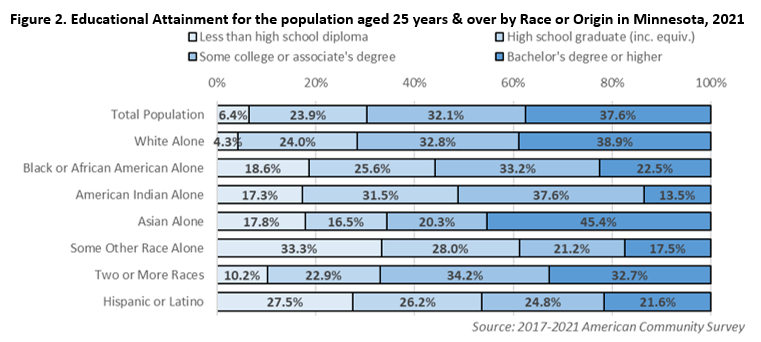
According to 2021 ACS 1-year estimates, a very similar percentage of Minnesota's Hispanic or Latino adults aged 25 years and over have at least a high school diploma compared to the U.S. overall (72.2% vs. 72.4%). However, ACS data also shows that Minnesota's Hispanic or Latino residents have a higher percentage with a bachelor's degree or higher (22.3% vs. 19.7%) than the U.S. overall. In comparison, 96.6% of the white alone, not Hispanic or Latino population in Minnesota graduated from high school, and 40.7% have a bachelor's degree or higher. In the U.S., 94% of the non-Hispanic or Latino white adult population has a high school diploma, and 38.9% have a bachelor's degree or higher.
Minnesota has one of the highest college participation rates, ranking 4th nationally, but racial and ethnic disparities in outcomes are unfortunately also top-ranked. As Alessia Leibert detailed in her March 2021 article on racial gaps in postsecondary educational attainment, Minnesota's "white and Asian high school students were the most likely (81% and 83% respectively) to enroll in college, while … nearly half (47%) of Black students enrolled but did not complete any credential. Finally, only 18% of Latino and Black students … completed a bachelor's degree or higher credential versus 32% of white and Asian students."3
Minnesota ranks 29th highest for the percent of Hispanic or Latino adults who have at least a high school diploma at 72.2%. That was right behind Wisconsin in 28th at 72.3%, and well behind North Dakota (8th, 82.2%) and South Dakota (18th, 76.7%), but ahead of Iowa in 35th at 70.3%. Reflecting our higher college participation, Minnesota ranks 18th for the percent of Hispanic or Latino adults with a bachelor's degree or higher, which was the highest in the region – ahead of South Dakota (22nd, 21.3%), North Dakota (25th, 20.1%), Wisconsin (40th, 17.2%) and Iowa (43rd, 16.6%).
Encouragingly, educational attainment has been increasing for Hispanic or Latino Minnesotans in recent years. While Minnesota's Hispanic or Latino population aged 25 years and over increased 25% between 2015 and 2021, a gain of just over 34,000 people, the number of Hispanic or Latino adults with a high school diploma increased 40% and the number with a bachelor's degree or higher expanded by nearly 60%. In all cases, that exceeded the U.S. rates of growth. However, the percent of Hispanic or Latino adults with a high school diploma was still 24.4% lower than for white adults; and the percent who had a bachelor's degree or higher was 18.4% lower.
Some of this educational attainment gap is a reflection of the barriers faced by the foreign-born Hispanic or Latino population – many new immigrants have very low educational attainment. According to IPUMS data from the 2020 ACS4, over half of native-born Hispanic or Latino adults aged 25 years and over in Minnesota had college experience, including 27.4% that have a bachelor's degree or higher. In contrast, almost 70% of foreign-born Hispanic or Latino adults had a high school diploma or less, and less than one-third had any college experience (see Table 4).
| Table 4. Educational Attainment for Minnesota's Hispanic or Latino Adults Aged 25 Years & Over by Birthplace, 2020 | Native-Born | Foreign-Born | ||
|---|---|---|---|---|
| Number | Percent | Number | Percent | |
| Less than High School | 5,303 | 8.4% | 27,602 | 33.6% |
| High School Diploma or Equivalent | 23,655 | 37.6% | 28,968 | 35.3% |
| 1 year of college | 10,052 | 16.0% | 7,233 | 8.8% |
| 2 years of college | 6,717 | 10.7% | 3,767 | 4.6% |
| Bachelor's Degree or Higher | 17,265 | 27.4% | 14,597 | 17.8% |
| Total, Hispanic or Latino Adults | 62,992 | 100.0% | 82,167 | 100.0% |
| Source: IPUMS USA, 2016-2020 American Community Survey | ||||
Increasing educational attainment typically leads to better labor force participation and employment outcomes. At 68.4% in 2021, Minnesota's labor force participation rate was 4th highest overall (behind D.C., Utah, and Nebraska), and was much higher than the country as a whole(63.0%). It was also highest in the Midwest, though our neighboring states are also hard working, with North Dakota (6th, 68.1%), South Dakota (10th, 66.6%), Iowa (11th, 66.1%), and Wisconsin (18th, 65.1%) all ranked in the top 20.
At 77.5%, workers of Hispanic or Latino origin had the highest labor force participation rate in the state of any race or origin group, and their rate was more than 10% higher than the state's white rate (67.2%). At that level, there were just over 175,000 Hispanic or Latino workers in Minnesota in 2021, accounting for 5.6% of the total workforce (see Table 5). That was up from 118,000 workers in 2011, or 4.0% of the state's total labor force a decade ago. The increase of nearly 57,000 Hispanic or Latino workers in the state accounted for more than one-third (35.7%) of the state's total gain of just under 160,000 workers from 2011 to 2021.
| Table 5. Employment Characteristics by Race & Hispanic or Latino Origin, 2021 | |||||
|---|---|---|---|---|---|
| - | Minnesota | United States | |||
| - | In Labor Force | Labor Force Participation Rate | Unemployment Rate | Labor Force Participation Rate | Unemployment Rate |
| Total Labor Force | 3,115,022 | 68.4% | 4.9% | 63.0% | 6.3% |
| White alone | 2,462,965 | 67.2% | 4.2% | 61.7% | 5.1% |
| Black or African American | 191,755 | 70.5% | 11.0% | 62.3% | 10.6% |
| American Indian & Alaska Native | 22,392 | 60.3% | 10.5% | 61.8% | 9.1% |
| Asian | 167,787 | 75.3% | 4.2% | 65.9% | 5.8% |
| Some Other Race | 84,746 | 77.3% | 6.3% | 67.9% | 7.7% |
| Two or More Races | 182,381 | 74.2% | 7.2% | 66.6% | 7.5% |
| Hispanic or Latino | 175,003 | 77.5% | 7.7% | 67.5% | 7.5% |
| Source: 2021 American Community Survey, 1-Year Estimates | |||||
Comparing data using the 2021 ACS, Minnesota's Hispanic or Latino labor force participation rate was 3rd highest in the U.S. (behind D.C. and North Dakota), though all neighboring states were also high: South Dakota (5th, 75.5%), Iowa (6th, 75.0%), and Wisconsin (17th, 71.9%). The U.S. rate was 67.5%, which was barely changed from 2011, when it was 67.4%. In contrast, Minnesota's Hispanic or Latino labor force participation rate rose 4.4 percentage points, which was the third largest increase in the U.S. South Dakota had the 6th largest increase (+3.2%), Iowa ranked 12th (+1.7%), Wisconsin was 18th (+0.9%), and North Dakota held steady at 77.7% in both years. In contrast, 23 other states saw a decline in their Hispanic or Latino labor force participation rate over the past decade.
While Minnesota's Hispanic or Latino labor force has increased, the state's white population has continued aging, and the white labor force participation rate declined over the past decade. More recent data from the Current Population Survey displays these long-term trends and how they accelerated during the pandemic in 2020 and 2021. While the white rate declined slowly and steadily from 70.0% in January 2020 to 68.1% in October 2022, the Hispanic or Latino rate actually increased from 76.2% to a peak of 80.4% in August of 2022; then experienced a sudden drop to 77.2% through October of 2022, though that is still up compared to October of 2020. The Hispanic or Latino labor force trend line is pointed upward, while the state's white labor force participation trend line is on a slow but steady decline (see Figure 3).
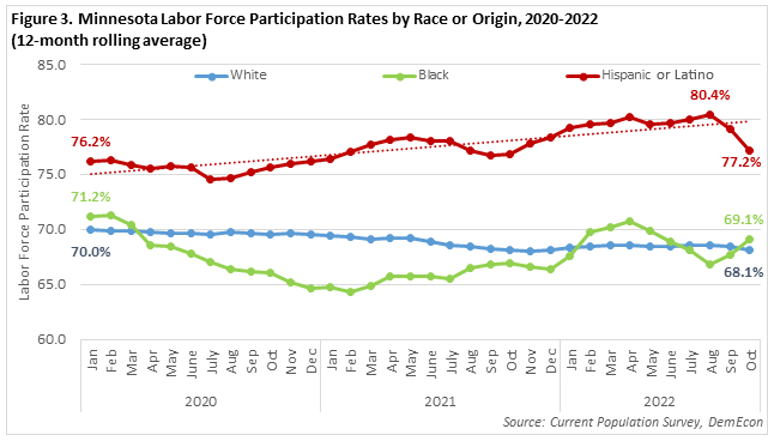
Interestingly, according to the IPUMS data from the 2020 ACS, the labor force participation rate for native-born Hispanic or Latino Minnesota residents was 75.9%, compared to 78.4% for foreign-born Hispanic or Latino residents. This shows that foreign-born workers are ready to work and quickly join the labor force, but both rates are comparatively high and show the importance of Hispanic or Latino workers in Minnesota's economy.
The data show some other immediate impacts from the pandemic recession, both in rising labor force participation rates and also in rising unemployment. Over time, Minnesota has had a significant gap between its white unemployment rate and rates for workers of other races or origins, with the Hispanic or Latino rate typically hovering well above the white rate. Going back to 2011, at the end of the Great Recession, the Hispanic or Latino unemployment rate was 11.0% in Minnesota, which was nearly double the white rate of 6.7%, a gap of 4.3%.
At that same time nationally, the Hispanic or Latino unemployment rate was 12.5% and the white rate was 8.9%, showing Minnesota had a lower rate but a bigger gap for Hispanic or Latino workers in 2011. Among the 50 states and D.C., Minnesota had the 30th highest unemployment rate for Hispanic or Latino residents in 2011, but the 20th largest gap between the white and Hispanic or Latino rate. The gap in rates was common in the Midwest, with South Dakota showing the largest gap, followed by North Dakota in 9th, Wisconsin in 23rd, and Iowa in 27th.
But as shown by the increase in labor force participation and employment noted above, over the course of the decade, employment prospects for Hispanic or Latino workers improved in Minnesota. The unemployment rate had dropped to 5.8% in 2019, before the pandemic, though that was the 13th highest unemployment rate for Hispanic or Latino residents in the U.S. at the time. Although the gap between white residents and Hispanic or Latino residents had decreased to 3.3 percentage points, Minnesota still had the 6th largest gap between the two, with the white unemployment rate at 2.5% in 2019.
However, following the outset of the pandemic in April of 2020, Hispanic or Latino workers suffered worse outcomes and unemployment rates jumped back up over the course of the next year, hovering between 6.1% and 8.3% until finally dropping to 5.5% in August of 2021. Since then, unemployment rates for Hispanic or Latino workers have continued to drop rapidly, even nearly matching the white rate by June of 2022, before starting to inch back up in the fall of 2022. In October of 2022, the Hispanic or Latino rate was just 3.8%, which was still nearly double the white rate of 2.1%; but down 1.2 percentage points since February of 2020, the biggest drop across the three race and origin groups profiled in Minnesota (see Figure 4).
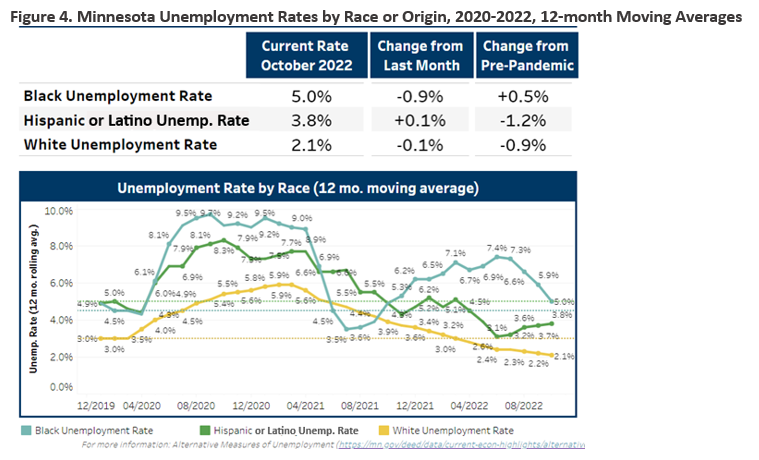
These higher unemployment rates and the fluctuations paint a constantly changing picture of struggle and success by race and origin. Looking at unemployment activity at the outset of the pandemic, in 2020 there were nearly 1,250,000 initial claims for Unemployment Insurance (UI) benefits filed by workers in Minnesota, nearly triple the number filed in 2009 during the Great Recession, which was the previous high. Of the initial claims in 2020, about 74% were filed by white residents, compared to just over 5% of claims filed by Hispanic or Latino residents, and nearly 10% of claims filed by Black or African Americans (see Figure 5).
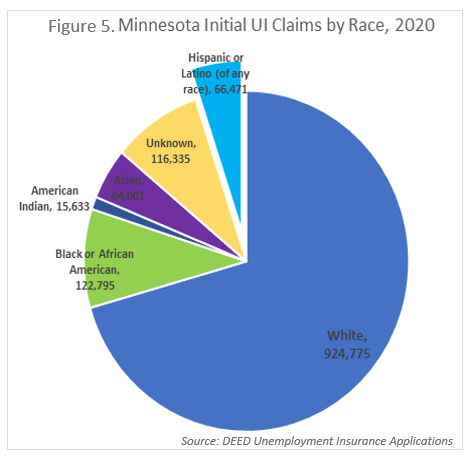
The number of UI continued claims for Hispanic or Latino workers saw an unprecedented 745% increase from April 2019 to April 2020, though that was slower than for white residents (+904.2%) at the outset of the pandemic. The 160,625 total continued claims filed by Hispanic or Latino workers in 2020 is easily the largest number on record, dwarfing the previous record of 48,722 set back in 2009 during the Great Recession.
As the economy recovered and people got back to work, Hispanic or Latino residents then saw a slower decrease in UI continued claims from April 2020 to April 2021 (-69.0% compared to -75.7% for white residents). And while the number of continued claims filed by white residents was -2.7% lower in April 2022 than April 2019, the number of continued claims for Hispanic or Latino residents was still elevated by just over 24% in April 2022 compared to 2019, showing their return to work has not been as smooth or successful.
Looking at more recent data for October of 2022, there were still 1,583 continued claims filed for Hispanic or Latino workers, which was up about 45% compared to October of 2019. For white residents, there were 16,946 continued claims in October 2022, which was down -2.4% compared to October 2019.
Along with the declining labor force participation described above, UI data also shows that the average duration of unemployment was slightly longer for Hispanic or Latino residents than for white residents. The average number of UI weeks climbed to 20.8 weeks for Hispanic or Latino residents from March of 2020 to March of 2021, compared to just 18.4 weeks for white residents, but much worse outcomes for Black residents (27.4 weeks), people of mixed race (23.7 weeks), and American Indians (23.3 weeks). In addition, Hispanic or Latino residents were also much more likely to still be filing continued claims for unemployment insurance benefits after March 5, 2021, at 28.0%, compared to just 22.0% for white residents (see Figure 6).

While the majority of Minnesota's total jobs are held by workers reporting as white, recent and historical trends show the state's workforce is becoming increasingly racially and ethnically diverse with each passing year. Workers reporting as Hispanic or Latino, for example, held 2.7% of the state's total jobs in the 3rd quarter of 2000, which increased to 3.6% in 2010, and to 5.1% in 2020 (see Figure 7).

After the severe job loss due to the pandemic recession in early 2020, Minnesota's economy began adding jobs again in late 2020 and throughout 2021 and 2022. According to Quarterly Workforce Indicators data from the U.S. Census Bureau, Minnesota had an average of 2,803,725 jobs in the third quarter of 2021. Broken down by race, nearly six-in-seven jobs (84.8%) were held by persons reporting as white. Hispanic or Latino workers accounted for 5.3% of the state's jobs in 2021.
Despite the pandemic recession, Minnesota's total employment still increased 8.7% from 2010 to 2021. This was equivalent to about 219,000 additional jobs. At a more detailed level, the number of jobs held by those reporting as white increased by 3% during this time (about 67,000 jobs), while jobs held by those reporting as a race other than white increased by 57% (about 152,000 jobs). Hispanic or Latino workers witnessed the second largest numeric increase in jobs for non-white workers between 2010 and 2021, adding approximately 56,000 jobs. Data clearly show that Minnesota's economy would not have been able to expand without our growing, diverse labor force (see Table 6).
| Table 6. Minnesota Employment by Race and Ethnicity, 2010-2021 | 2010 Jobs | 2021 Jobs | 2010-2021 Change | |||
|---|---|---|---|---|---|---|
| Number | Share | Number | Share | Numeric | Percent | |
| Total, All Jobs | 2,529,957 | 100.00% | 2,749,155 | 100.00% | +219,198 | +8.7% |
| White | 2,262,982 | 89.4% | 2,330,011 | 84.8% | +67,029 | +3.0% |
| Black or African American | 113,578 | 4.5% | 182,498 | 6.6% | +68,920 | +60.7% |
| American Indian or Alaska Native | 20,614 | 0.8% | 25,473 | 0.9% | +4,859 | +23.6% |
| Asian | 100,959 | 4.0% | 156,904 | 5.7% | +55,945 | +55.4% |
| Two or More Race Groups | 31,824 | 1.3% | 54,269 | 2.0% | +22,445 | +70.5% |
| Hispanic or Latino (of any race) | 89,837 | 3.6% | 145,900 | 5.3% | +56,063 | +62.4% |
| Source: Quarterly Workforce Indicators | ||||||
At 15.0%, Minnesota's share of jobs held by non-white workers placed it 30th in the nation.5 While Minnesota does not place near the top of the nation's states with the most diverse workforces, its large numeric and rapid percentage growth of racially and ethnically diverse workers ranks much more highly. In fact, the 53.5% increase in jobs held by non-white workers between 2010 and 2020 placed it 7th in the nation. Only Illinois, North Dakota, Utah, Iowa, Idaho, and Maine had faster growth rates in this regard.
Looking back further and more specifically by ethnicity, the number of jobs held by Hispanic or Latino workers in Minnesota more than doubled between 2000 and 2021 – from 67,279 jobs to 145,900 jobs in 2021, a 116.9% increase. All 20 main industries added Hispanic or Latino workers over the past 2 decades in Minnesota, but growth rates varied by industry.
With nearly 26,500 jobs, the largest number of Hispanic or Latino workers are employed in the Manufacturing industry, accounting for 8.5% of total employment in the industry. While the total number of Manufacturing jobs dropped -22.4% from 2000 to 2021, the number of Hispanic or Latino workers increased 57.6%, rising from 16,795 jobs in 2000. Most notably, 11,685 Hispanic or Latino residents work in the Food Manufacturing subsector, easily the highest number of any subsector. Hispanics account for 24.8% of total employment in Food Manufacturing, and while Food Manufacturing cut jobs by -3.3% from 2000 to 2021, the number of Hispanic or Latino workers rose 49.7%. Food Manufacturing firms have recruited and retained Hispanic or Latino workers for decades.
The largest and fastest increase in employment for Hispanic or Latino workers occurred in Health Care & Social Assistance, which jumped from 4,671 jobs in 2000 to 20,659 jobs in 2021, a 342.3% expansion. Hispanic or Latino residents now account for 4.1% of the jobs in the industry, up from just 1.6% in 2000. Interestingly, while jobs in Health Care & Social Assistance dropped by -2.0% from 2019 to 2020, the number of jobs held by Hispanic or Latino workers increased by 2.5% as these workers took on jobs that were hard to fill in the midst of a pandemic. Health Care employment then jumped another 7.6% for Hispanic or Latino workers from 2020 to 2021, outpacing the overall industry recovery of 3.9%.
The next three largest industries for Hispanic or Latino workers are Accommodation & Food Services, Retail Trade, and Administrative Support & Waste Management Services. Hispanic or Latino employment ramped up 155% in Retail Trade and doubled in Accommodation & Food Services from 2000 to 2021. Growth was much more gradual in Administrative Support & Waste Management Services. In 2000, it had the third largest number of Hispanic or Latino workers, but as those workers have moved from temporary staffing into more permanent positions, it is now the fifth largest (see figure 8).
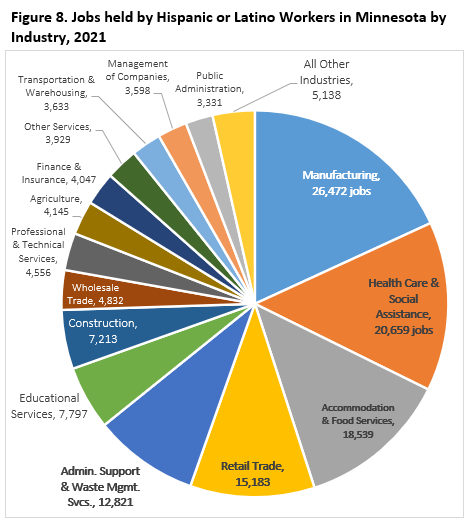
Over 18% of Hispanic or Latino workers are employed in Manufacturing, compared to 11.2% of white workers. Another 14.2% of Hispanic or Latino workers held jobs in Health Care & Social Assistance, compared to 16.9% of white residents; 12.7% are employed in Accommodation & Food Services, compared to 6.4% of white residents; 10.4% are employed in Retail Trade, right in line with 10.2% of white residents; and 8.8% are employed in Administrative Support & Waste Management Services, compared to 4.1% of white residents. Hispanic or Latino residents also have a much higher share of workers in Agriculture – 2.8% compared to 0.9% of white residents.
As noted above, Hispanic or Latino residents held about 5.3% of total jobs in the state, but over 10% of the workforce in both Administrative Support & Waste Management Services and Accommodation & Food Services are Hispanic or Latino. After tripling over the past 21 years, the industry with the highest concentration of Hispanic or Latino workers is Agriculture, where 17.8% of jobs are held by workers of Hispanic or Latino origin. Including Manufacturing, the only other industry that has an above average concentration is Retail Trade, at 5.5%. In contrast, the industries with the smallest number and concentration of Hispanic or Latino workers include Mining and Utilities, which combined have just 250 Hispanic or Latino workers (see Table 7).
| Table 7. Minnesota Workforce Demographics by Industry, 2000-2021 | Number of Jobs Held by Hispanic or Latino Workers by Year | Percent of Jobs Held by Hispanic or Latino Workers by Year | Change in Jobs Held by Hispanic or Latino Workers | |||||||
|---|---|---|---|---|---|---|---|---|---|---|
| 2000 | 2019 | 2020 | 2021 | 2000 | 2019 | 2020 | 2021 | 2000-2021 | 2000-2021 | |
| Total, All Industries | 67,279 | 142,841 | 138,612 | 145,900 | 2.6% | 4.9% | 5.1% | 5.3% | +78,621 | +116.9% |
| Manufacturing | 16,795 | 25,113 | 25,091 | 26,472 | 4.2% | 7.6% | 7.9% | 8.5% | +9,677 | +57.6% |
| Health Care & Social Assistance | 4,671 | 18,721 | 19,191 | 20,659 | 1.6% | 3.8% | 3.9% | 4.1% | +15,988 | +342.3% |
| Accommodation & Food Services | 9,188 | 22,156 | 18,617 | 18,539 | 5.0% | 9.7% | 10.0% | 10.1% | +9,351 | +101.8% |
| Retail Trade | 5,946 | 13,658 | 13,906 | 15,183 | 1.9% | 4.9% | 5.1% | 5.5% | +9,237 | +155.3% |
| Admin. Support & Waste Mgmt. Svcs. | 9,105 | 12,805 | 12,140 | 12,821 | 6.9% | 9.5% | 10.1% | 10.3% | +3,716 | +40.8% |
| Educational Services | 2,316 | 7,680 | 7,684 | 7,797 | 1.3% | 3.0% | 3.1% | 3.3% | +5,481 | +236.7% |
| Construction | 2,085 | 6,394 | 6,427 | 7,213 | 1.6% | 4.4% | 4.5% | 4.8% | +5,128 | +245.9% |
| Wholesale Trade | 2,565 | 4,521 | 4,576 | 4,832 | 1.9% | 3.6% | 3.7% | 3.9% | +2,267 | +88.4% |
| Professional & Technical Services | 1,681 | 4,245 | 4,228 | 4,556 | 1.3% | 2.6% | 2.7% | 2.8% | +2,875 | +171.0% |
| Agriculture | 1,233 | 3,608 | 3,959 | 4,145 | 8.4% | 16.0% | 17.2% | 17.8% | +2,912 | +236.2% |
| Finance & Insurance | 1,751 | 3,932 | 4,071 | 4,047 | 1.4% | 2.7% | 2.9% | 2.9% | +2,296 | +131.1% |
| Other Services | 2,121 | 4,270 | 3,798 | 3,929 | 2.4% | 4.5% | 4.6% | 4.7% | +1,808 | +85.2% |
| Transportation & Warehousing | 1,721 | 3,464 | 3,433 | 3,633 | 2.0% | 4.1% | 4.4% | 4.8% | +1,912 | +111.1% |
| Management of Companies | 1,483 | 3,365 | 3,389 | 3,598 | 1.8% | 3.4% | 3.5% | 3.8% | +2,115 | +142.6% |
| Public Administration | 1,407 | 3,141 | 3,076 | 3,331 | 1.4% | 2.6% | 2.6% | 2.8% | +1,924 | +136.7% |
| Arts, Entertainment & Recreation | 1,082 | 2,621 | 1,920 | 1,889 | 2.5% | 4.4% | 4.3% | 4.4% | +807 | +74.6% |
| Real Estate, Rental & Leasing | 805 | 1,630 | 1,605 | 1,732 | 2.1% | 4.7% | 4.8% | 5.2% | +927 | +115.2% |
| Information | 1,151 | 1,307 | 1,271 | 1,267 | 1.6% | 2.7% | 2.9% | 2.9% | +116 | +10.1% |
| Utilities | 132 | 157 | 167 | 176 | 1.0% | 1.5% | 1.7% | 1.7% | +44 | +33.3% |
| Mining | 32 | 49 | 56 | 74 | 0.4% | 0.8% | 1.0% | 1.4% | +42 | +131.3% |
| Source: Quarterly Workforce Indicators | ||||||||||
Just like Hispanic or Latino workers are more likely to be employed in certain industries, there are also differences in the occupations that are held by Hispanic or Latino residents. Again, detailed data from the IPUMS USA database6 show that the most common occupations for Hispanic or Latino Minnesotans are Chefs & Cooks, followed by Janitors & Building Cleaners, Cashiers, Maids & Housekeeping Cleaners, Retail Salespersons, and Food Preparation Workers. As shown in Table 8, Hispanic or Latino workers account for over 20% of employment in several occupations in Minnesota, including Roofers, Packers & Packagers, Butchers & Meat Cutters, Packaging & Filling Machine Operators, Food Processing Workers, Media & Communication Workers, Cutting Workers, Insulation Workers, Sewing Machine Operators, Electronic Home Entertainment Equipment Installers, Furniture Finishers, Mining Machine Operators, and Upholsterers.
Among the top 25 occupations held by Hispanic or Latino workers in Minnesota, all but two – Managers and Elementary & Middle School Teachers – can be started with a high school diploma or less, relying on on-the-job training rather than postsecondary education. There are some occupational groupings – food preparation and serving, building and grounds cleaning and maintenance, sales and related, agriculture, and construction and extraction – that show high concentrations of Hispanic or Latino workers. In contrast, there are 100 occupations that did not show any Hispanic or Latino workers in Minnesota.
| Table 8. Top 25 Occupations held by Hispanic or Latino Workers in Minnesota, 2020 | Number of Hispanic or Latino Workers | Percent of Total Hispanic Workers | Non- Hispanic Workers | Percent of Non-Hispanic Workers | Total Workers, All Races & Origins | Hispanic Percent of Total Workers |
|---|---|---|---|---|---|---|
| Chefs & Cooks | 9,608 | 5.5% | 50,382 | 1.5% | 59,990 | 16.0% |
| Janitors & Building Cleaners | 6,445 | 3.7% | 54,560 | 1.6% | 61,005 | 10.6% |
| Cashiers | 6,129 | 3.5% | 70,052 | 2.1% | 76,181 | 8.0% |
| Maids & Housekeeping Cleaners | 4,071 | 2.3% | 23,115 | 0.7% | 27,186 | 15.0% |
| Retail Salespersons | 3,944 | 2.3% | 70,657 | 2.1% | 74,601 | 5.3% |
| Food Preparation Workers | 3,589 | 2.1% | 22,334 | 0.7% | 25,923 | 13.8% |
| First-Line Supervisors of Sales Workers | 3,581 | 2.1% | 87,880 | 2.6% | 91,461 | 3.9% |
| Agricultural Workers | 3,487 | 2.0% | 21,032 | 0.6% | 24,519 | 14.2% |
| Other production workers inc. semiconductor processors & cooling & freezing equip. operators | 3,224 | 1.9% | 29,097 | 0.9% | 32,321 | 10.0% |
| Construction Laborers | 3,127 | 1.8% | 31,179 | 0.9% | 34,306 | 9.1% |
| Waiters & Waitresses | 3,110 | 1.8% | 40,965 | 1.2% | 44,075 | 7.1% |
| Laborers & Freight, Stock & Material Movers, Hand | 3,085 | 1.8% | 51,558 | 1.5% | 54,643 | 5.6% |
| Customer Service Representatives | 3,070 | 1.8% | 65,248 | 1.9% | 68,318 | 4.5% |
| Nursing, Psychiatric, & Home Health Aides | 2,787 | 1.6% | 48,187 | 1.4% | 50,974 | 5.5% |
| Driver/Sales Workers & Truck Drivers | 2,774 | 1.6% | 75,529 | 2.2% | 78,303 | 3.5% |
| Packers & Packagers, Hand | 2,490 | 1.4% | 9,761 | 0.3% | 12,251 | 20.3% |
| Managers (including Postmasters) | 2,425 | 1.4% | 99,752 | 2.9% | 102,177 | 2.4% |
| Personal Care Aides | 2,412 | 1.4% | 46,608 | 1.4% | 49,020 | 4.9% |
| Assemblers & Fabricators | 2,317 | 1.3% | 33,594 | 1.0% | 35,911 | 6.5% |
| Stock Clerks & Order Fillers | 2,014 | 1.2% | 36,704 | 1.1% | 38,718 | 5.2% |
| Elementary and Middle School Teachers | 2,009 | 1.2% | 72,266 | 2.1% | 74,275 | 2.7% |
| Grounds Maintenance Workers | 2,007 | 1.2% | 27,643 | 0.8% | 29,650 | 6.8% |
| Carpenters | 1,946 | 1.1% | 27,692 | 0.8% | 29,638 | 6.6% |
| Roofers | 1,847 | 1.1% | 3,065 | 0.1% | 4,912 | 37.6% |
| Teacher Assistants | 1,751 | 1.0% | 39,506 | 1.2% | 41,257 | 4.2% |
| Source: U.S. Census Bureau, IPUMS USA, University of Minnesota, IPUMS Center for Data Integration | ||||||
The Census Bureau's Annual Business Survey7 shows that with 1,768 firms, Hispanic or Latino owners account for about 1.6% of business ownership among classifiable employer firms in Minnesota in 2019. This included 1,588 firms owned by Hispanic or Latino residents, and another 180 firms that are equally Hispanic/non-Hispanic owned. White people account for nearly 88.5% of businesses owned in Minnesota, 3.4% are owned by Asians, about 1.4% have Black or African American ownership, and less than a half percent of firms are owned by American Indians. In each case other than white, the percent of business ownership is lower than each race group's share of the total labor force, with the second biggest gap shown for Hispanic or Latino people (see Figure 9).
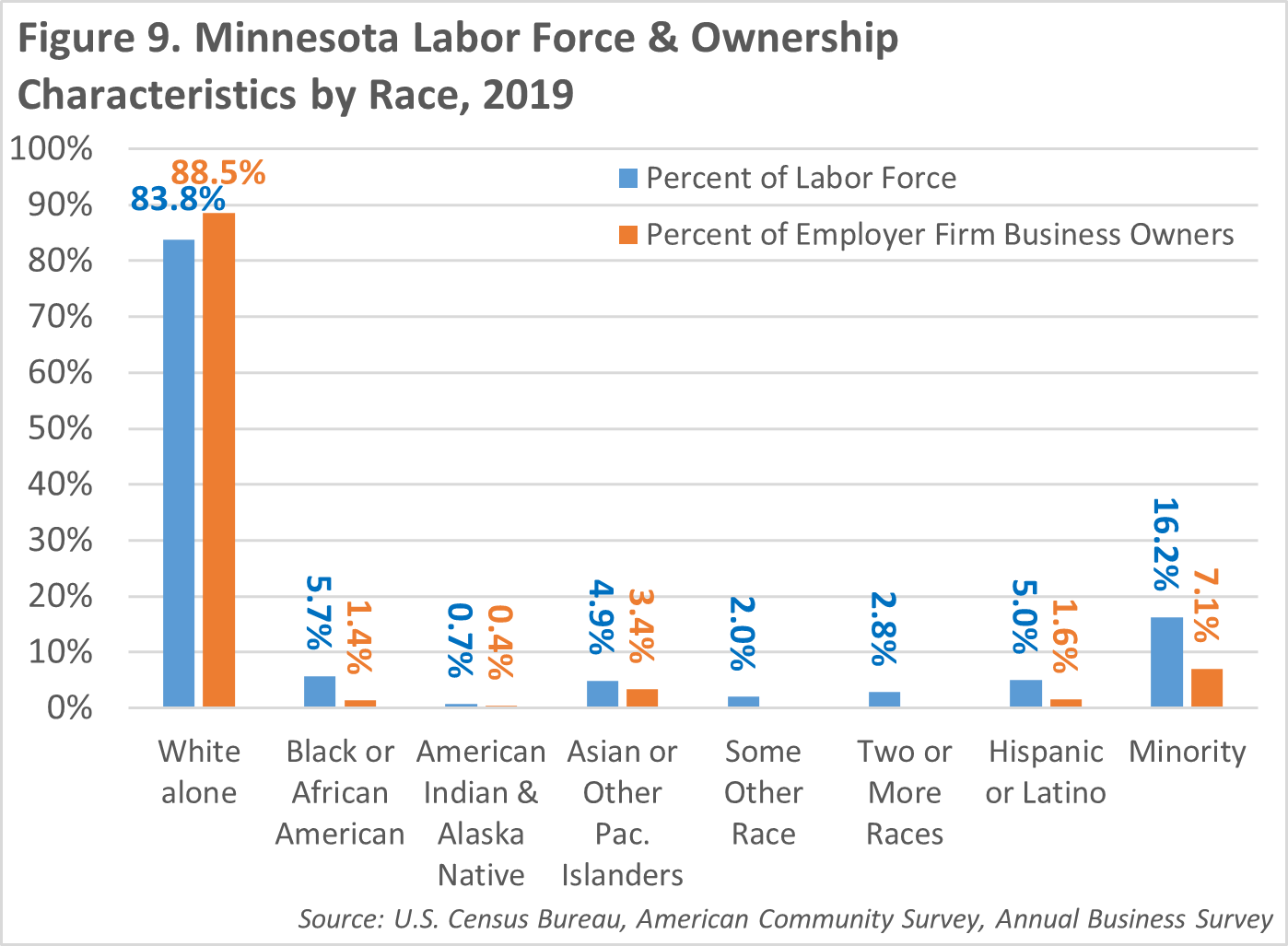
Similar to our overall population, Minnesota's business ownership of firms that employ others is less racially diverse than the U.S. For comparison, about 6.9% of all classifiable firms in the U.S. were Hispanic or Latino-owned in 2019. While our Hispanic or Latino ownership is relatively low, even more encouragingly, Minnesota saw a 75.2% increase in the number of Hispanic or Latino-owned employer firms from 2012 to 2019, compared to a 2.6% increase across all ownerships. In other words, Minnesota still has a smaller percentage of Hispanic or Latino-owned firms, but was seeing much faster growth in Hispanic or Latino ownership over the past decade.
Minnesota's 1,768 Hispanic or Latino-owned businesses employed about 17,200 paid employees in 2019. Most detailed data at the industry level is not disclosed in the dataset, but the industries with the largest number of employers include Construction (321 firms), Professional & Technical Services (196 firms), Wholesale Trade (42 firms) and Manufacturing (41 firms). And though the number of firms is not disclosed, the dataset does show a significant number of employees at Hispanic or Latino-owned businesses in Accommodation & Food Services, Retail Trade, Administrative Support & Waste Management Services, and Health Care & Social Assistance.
In addition, there were 10,500 Hispanic or Latino-owned nonemployer (or self-employed) firms in Minnesota in 2017 according to the Census Bureau's Nonemployer Statistics program. At that level, Hispanic or Latino residents accounted for 2.6% of self-employed firms in the state. The number of self-employed Hispanic or Latino firms in Minnesota increased 33.2% from 2012 to 2017, which was nearly 5 times faster than the number of nonemployers increased overall.
Racial disparities exist in employment characteristics and are also found in economic outcomes as measured by household income and poverty levels. The U.S. median household income climbed to $69,717 in 2021, which was about $8,000 lower than Minnesota's median household income of $77,720. At that level, Minnesota's median household income was the 14th highest in the United States, well ahead of all surrounding states including Wisconsin ($67,125 ; 23rd), North Dakota ($66,519 ; 27th), South Dakota ($66,143 ; 30th), and Iowa ($65,600 ; 31st). Minnesota has had above average incomes for several decades and is well known and established as a high income state.
However, median household incomes varied widely by racial groups in the state and country. At $64,102 the median income for Hispanic or Latino households in Minnesota was significantly lower – about $17,000 lower – than those of non-Hispanic white residents. Except for Asians, all other households of color in the state also had notably lower household incomes than white residents (see Figure 10). Hispanic or Latino household income in Minnesota is slightly above the U.S. median of $60,566 for Hispanic or Latino households, Minnesota had the 12th highest level, again ahead of surrounding states South Dakota ($57,045 ; 26th), Wisconsin ($53,186 ; 38th), Iowa ($52,082 ; 41st), and North Dakota ($51,546 ; 43rd).
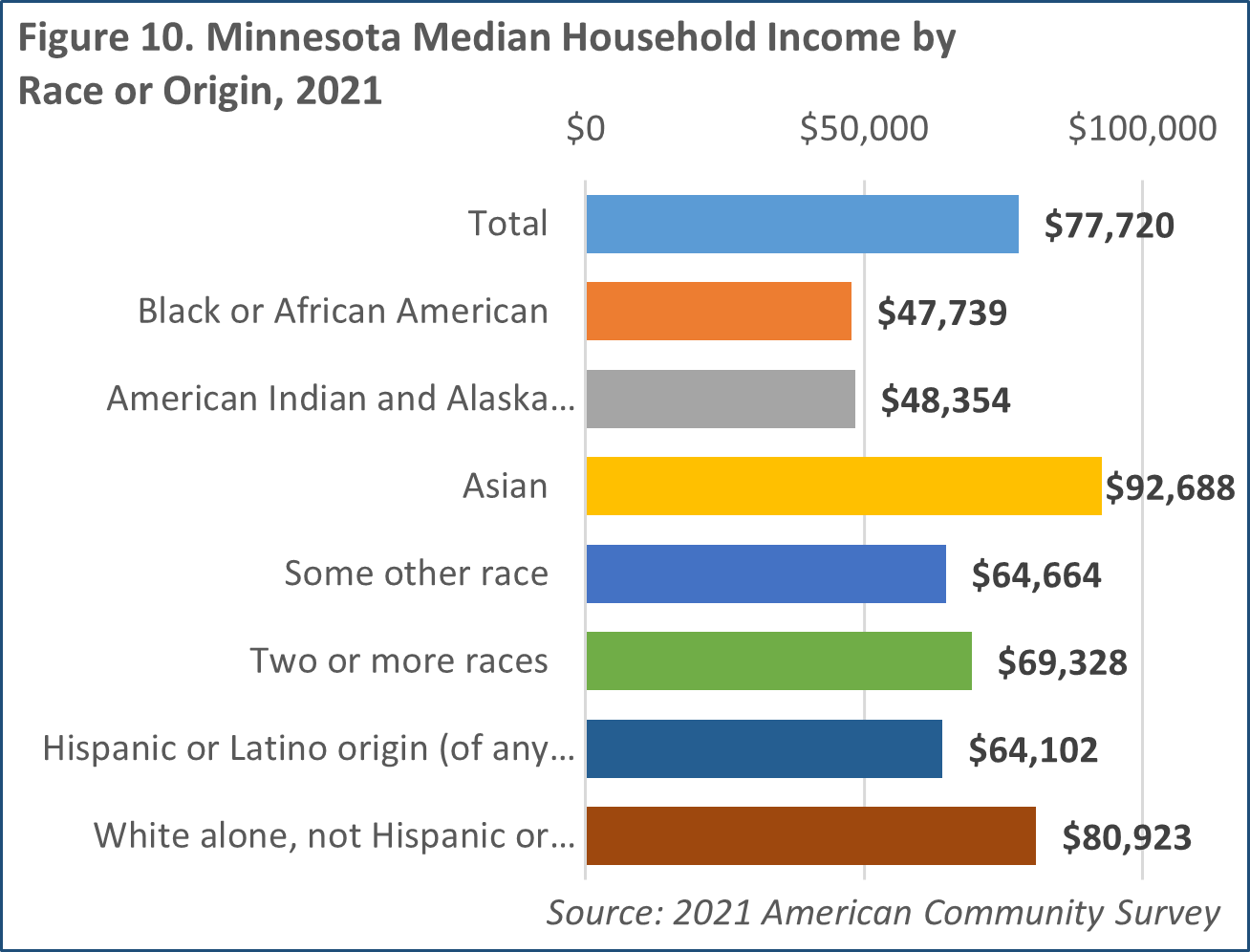
In the last decade, median incomes for Hispanic or Latino households in Minnesota have experienced a significant increase, rising by 69.6% from 2011 to 2021. This growth rate ranked 7th highest in the United States, where Hispanic or Latino household incomes increased by 53.0% on average. As a result, Minnesota climbed from 21st to the 12th highest median income level for Hispanic or Latino households in the U.S., surpassing nine other states along the way.
Minnesota's Hispanic or Latino households had higher incomes than Hispanic or Latino households in the U.S. overall. In 2021, Minnesota had a lower percentage of Hispanic or Latino households earning less than $50,000, and a slightly higher percentage of Hispanic or Latino households earning more than $100,000 than the U.S. (see Figure 11). About one-quarter of Hispanic or Latino households in Minnesota had income below $35,000 in 2021. In comparison, only 18.8% of non-Hispanic or Latino white households in Minnesota had incomes below $35,000. About 28.3% of Hispanic or Latino households in Minnesota had incomes above $100,000; compared to 39.6% of white households.
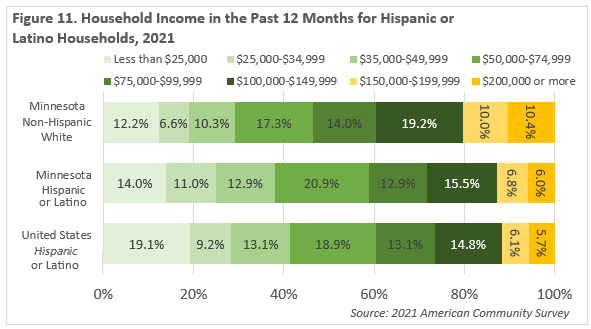
A final measure of economic outcome is the percent of the population below the poverty level, and again there are disparities between white residents and Hispanic or Latino residents in Minnesota. Overall, the state poverty rate was 9.3%, which is 3.5% below the national rate. However, in 2021 it was estimated that 14.5% of the state's Hispanic or Latino population had incomes below the poverty level, compared to just 7.5% of the white population. Still, Minnesota's Hispanic or Latino poverty rate was lower than the nation's Hispanic or Latino poverty rate (see Table 9).
| Table 9. Poverty Status in the past 12 months by Race or Origin in Minnesota, 2021 | Total Population (for whom poverty status is determined) | Income below the poverty level | Poverty Rate (% below poverty level) | U.S. Poverty Rate |
|---|---|---|---|---|
| Total Population | 5,587,189 | 519,731 | 9.3% | 12.8% |
| White Alone | 4,350,858 | 326,270 | 7.5% | 9.8% |
| Black or African American Alone | 373,562 | 78,080 | 20.9% | 21.8% |
| American Indian Alone | 44,271 | 10,809 | 24.4% | 21.4% |
| Asian Alone | 283,994 | 32,970 | 11.6% | 10.2% |
| Some Other Race Alone | 148,869 | 19,007 | 12.8% | 19.0% |
| Two or More Races | 383,809 | 52,381 | 13.6% | 15.4% |
| Hispanic or Latino | 325,017 | 46,981 | 14.5% | 17.5% |
| Source: 2021 American Community Survey, 1-Year Estimates | ||||
At 9.3%, Minnesota has the 3rd lowest poverty rate in the U.S., and was lower than all our neighboring states – Wisconsin (10.8% ; 14th lowest), Iowa (11.1% ; 16th), North Dakota (11.1% ; 16th), and South Dakota (12.3% ; 30th). For Hispanic or Latino residents, Minnesota had the 9th lowest poverty rate at 14.5%, which was well ahead of North Dakota (16.4% ; 21st lowest), Wisconsin (18.0% ; 25th), Iowa (19.4% ; 31st), and South Dakota (21.5% ; 41st).
Data show that the increase in Hispanic or Latino residents has had a positive impact on Minnesota's population, labor force, and economy. The Hispanic or Latino community has experienced significant growth, now making up over 6% of the state's population and more than 5% of the workforce. However, despite the economic opportunities that have emerged over the past two decades, disparities persist for Hispanic or Latino residents compared to their white counterparts.
With a tight labor market, the economic challenges and opportunities that Minnesota will face in the future are great and will need to be tackled with an equitable and multi-pronged approach to attracting, welcoming, retaining, and training workers of all demographic characteristics. Addressing the persistent disparities between the white and Hispanic or Latino populations is not only necessary to promote greater equity, but also essential for Minnesota's economic success. By closing these gaps, Minnesota can create a diverse, inclusive, and skilled workforce that can meet the needs of its employers and drive economic growth. Ultimately, investing in equity and inclusion is critical for building a stronger and more prosperous future for all Minnesotans.
1Note that Hispanic or Latino is the term used by the U.S. Census Bureau. This article uses those terms, but the author recognizes that some people prefer the term Latine or Latinx as gender-neutral terms.
2Steven Ruggles, Sarah Flood, Ronald Goeken, Megan Schouweiler and Matthew Sobek. IPUMS USA: Version 12.0 [dataset]. Minneapolis, MN: IPUMS, 2022.
3Leibert, Alessia. "How The Deck is Stacked." March 2021 Minnesota Economic Trends.
4Steven Ruggles, Sarah Flood, Ronald Goeken, Megan Schouweiler and Matthew Sobek. IPUMS USA: Version 12.0 [dataset]. Minneapolis, MN: IPUMS, 2022.
5O'Neill, Timothy. "Minnesota's Diversifying Workforce." March 2022 Economic Trends.
6Steven Ruggles, Sarah Flood, Ronald Goeken, Megan Schouweiler and Matthew Sobek. IPUMS USA: Version 12.0 [dataset]. Minneapolis, MN: IPUMS, 2022.
7The U.S. Census Bureau released new estimates on the characteristics of employer businesses in late 2021. According to the 2020 Annual Business Survey (ABS), which covers reference year 2019, approximately 18.7% (1.1 million) of U.S. employer businesses were minority-owned.